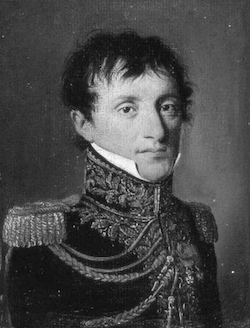General Amé Pierre Chastel

Born: April 29, 1774
Place of Birth: Veigy, Haute-Savoie, France
Died: October 18, 1826
Place of Death: Geneva, Switzerland
Arc de Triomphe: CHASTEL on the west pillar
Pronunciation:
The son of a notary, Amé Pierre Chastel first joined the military when he joined the cavalry of the Legion of Allobroges as a lieutenant in August of 1792. First posted to the Army of the Alps, he went to Italy and then returned to France to serve at the siege of Toulon . In January of 1794 Chastel received a promotion to capitaine and then in February he joined the 15th Dragoons. For the next few years he served in the Army of the Eastern Pyrenees before joining the Army of Italy in 1796. The following year he was wounded by a saber blow to the head during the crossing of the Tagliamento.
In 1798 Chastel was designated for the Army of the Orient and he took part in the expedition to Egypt as part of Desaix's troops. During his time in Egypt, he discovered the Dendera zodiac. After returning to France, Chastel was promoted to chef d'escadron in 1802. The next year he was assigned to the camp of Compiègne where he served with the 24th Dragoons. When the Grande Armée marched to war in 1805, Chastel took part in the campaign and served at the Battle of Austerlitz. A few weeks after the battle he joined the Grenadiers à Cheval of the Imperial Guard as a major. Over the next two years he took part in the campaigns in Prussia and Poland and in February of 1807 he was promoted to colonel.
In 1808 Chastel was named a Baron of the Empire and then sent to Spain, where he served at Burgos. The next year he took part in the Danube campaign against the Austrians. Chastel's next major assignment came in 1811 where he commanded the Grenadiers à Cheval of the Imperial Guard who were serving in Spain. While there he received a promotion to général de brigade. In 1812 General Chastel received a promotion to général de division and he left the Guard to take command of the 3rd Division of Light Cavalry of III Cavalry Corps. He led his men on the campaign against Russia and he fought at Borodino in September. For the campaigns in Saxony of 1813, he commanded the 3rd Light Cavalry Division in I Cavalry Corps. During the defense of France in 1814, Chastel served at the defense of Paris at the end of March. Afterwards, he was put on non-activity.
When in 1815 Napoleon returned from exile and resumed power, Chastel rallied to him and was given command of a cavalry division in the army. During the campaign that June, Chastel commanded the 10th Cavalry Division which served as part of Exelmans' corps. After Napoleon's second abdication, Chastel was put on non-activity and he retired to Switzerland.
Bibliography
- Divry, Arnauld. Les Noms Gravés sur l'Arc de Triomphe. Paris: L'Harmattan, 2017.
- Six, Georges. Dictionnaire Biographique des Généraux & Amiraux Français de la Révolution et de l'Empire (1792-1814). 2 vols. Paris: Gaston Saffroy, 2003.
Updated November 2024
© Nathan D. Jensen